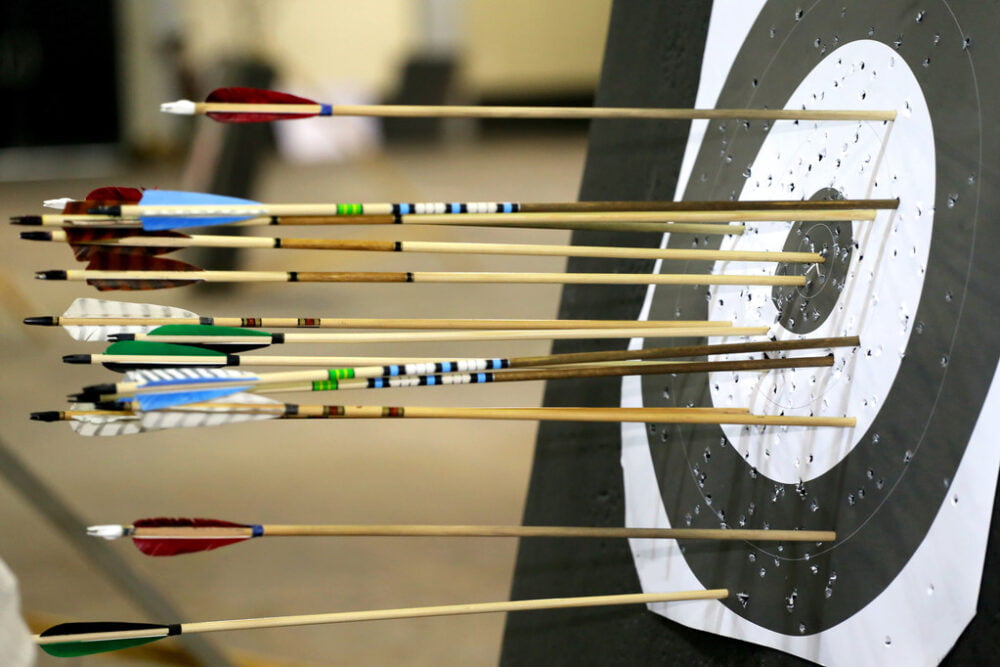In this final chapter of our PASS 2023 recap, we summarise the presentations that ventured into uncharted territories of personal armor and the emerging threats that challenge current standards. From the surprising potency of crossbow bolts against standard armor, to a sobering examination of ballistic helmet edge performance, and closing with the vulnerability of UHMWPE armor plates to angled impacts, these discussions have set the stage for a reexamination of existing standards.
Crossbows defeating modern body armor
In one of the more surprising sessions of the symposium, An Experimental Investigation Into the Threat Posed by Arrows to Body Armour, it was shown that light body armor is remarkably vulnerable to crossbow bolts. Using a 300-pound draw weight crossbow, the study conducted penetration tests with bolts armed with two types of tips, and ultimately demonstrated that all body armor systems tested, regardless of bolt tip type, were susceptible to penetration.
Soft body armor was tested with a gelatin backing to simulate human tissue. Not only was soft body armor easily and reliably penetrated, there was no significant protective benefit from additional stab protection elements like metal foil or chain mail. In other words, every tested soft armor system was penetrated, including stab-resistant and stab-rated soft armor. Even hard ballistic plates were penetrated, although these were entirely of UHMWPE construction, and the bolt tips didn’t penetrate very far into the gelatin blocks behind the plates. Helmets, too, were vulnerable; the bolts penetrated both Kevlar and UHMWPE helmets, and passed all the way through a hard surrogate headform, indicating a risk of significant injury.

The researchers concluded that commercially-available crossbows pose a distinct and serious threat to current body armor due to their unique terminal ballistic properties, which challenge armor materials in ways that combine stabbing dynamics with the high-rate effects typically observed in firearm ballistics. The findings suggest that armor design may do well to evolve to address this particular threat, and future testing should consider the impact of lower-energy crossbows to investigate material behavior more deeply and develop more effective protection solutions.
Helmet edge underperformance
In Edge Performance of Ballistic Helmets veteran researcher Phil Gotts, together with Paul Fenne from London’s Metropolitan Police, investigated the effects of ballistic impacts near the edges of high-cut ballistic helmets, an increasingly popular design choice among police forces for its ergonomic benefits and compatibility with equipment. This design, however, offers reduced coverage compared to traditional helmets, making the edge resistance critically important for overall protection.
The study aimed to establish a test method for assessing helmet performance near the edge, a relatively unexplored area in helmet testing. It sought to determine how close to the edge a helmet can withstand a shot without being penetrated. Notably, the team referenced the VPAM HVN 2009 standard, which includes an edge test but without clear historical evidence for the specified limits.
A series of tests with helmets procured from China, with some constructed from para-aramid and others constructed from UHMWPE, were subjected to ballistic impacts at varying distances from the edge. Utilizing high-speed video, the trials documented the impact events, providing insights into the behavior of the materials and the adhesive forces at play.
The findings revealed that both materials generally withstood impacts at 25mm from the edge, but as the distance decreased to 15mm, the helmets showed significantly less resistance, with virtually all impacts resulting in perforation. At a 20mm edge distance, the para-aramid helmets exhibited a mix of results, while the UHMWPE helmets were consistently penetrated, albeit sometimes only by parts of the fragmented bullet.
One of the key challenges highlighted was defining what constitutes a perforation at the edge, as the impact mechanisms differ from those occurring away from the edge. The study proposes that for edge impacts, a perforation should be considered as any event where the bullet maintains a forward trajectory capable of causing lethal injury.
This research by Gotts and Fenne highlights the extreme vulnerability of standard “IIIA” helmets to shots which impact near their edges — which is important information, as, statistically, helmets are very likely to be struck near an edge. Moreover, it may provide a foundation for a new testing methodology for helmet edges.
UHMWPE armor system resistance to angled impacts from mild steel cored bullets
In V50 Study of Light-Weight Body Armour Inserts under Angle Shot a Rheinmetall research group investigated the ballistic performance of Ultra-High Molecular Weight Polyethylene (UHMW-PE) inserts used in body armor, focusing on how different angles of impact affect their ballistic efficacy against the mild steel cored 7.62x39mm Type PS threat. This was no doubt influenced by results from VPAM protocol ballistic tests, where UHMWPE plates built to VPAM-6 are tested against that same 7.62x39mm MSC threat at a 30° angle.
Testing across angles from 0° to 30°, the study reveals that at a 20° to 30° angle, there is a 14% decrease in the v50 value (the velocity at which there is a 50% chance of penetration) for plates with a thickness of 12.7 mm. Notably, the impact at these angles causes different damage mechanisms compared to a straight-on shot (0°), leading to earlier delamination and less deformation in the projectile, which then deflects parallel to the layers, facing less resistance.
The research found that the delamination zone in the PE layers starts earlier and is more extensive with angled shots, requiring the layers closer to the body to absorb more residual energy. However, this angle effect is mitigated by increased plate thickness; plates that are 15.2 mm and 20.8 mm thick do not exhibit the same vulnerability to angled shots, with only a 6% reduction in v50 for the thicker material. The study also indicates that resin matrix composition (polyurethane versus rubber matrix, e.g. Dyneema HB-210 vs. HB-212) does not appear to significantly affect resistance to angled impacts, although the stiffer polyurethane matrix material showed a slight improvement.
Ultimately, the findings of this presentation confirm that – contrary to expectations from experiments in steel armor, where angled shots are always much more easily defeated – UHMWPE plates are vulnerable to impacts at an angle. Lightweight UHMWPE plates rated for x39mm MSC might not be capable of handling that same threat if it impacts at 30° rather than 0°! Impacts at 30° are no less likely than impacts at 0°, and may in fact be more likely. As mentioned previously, this may warrant a reexamination of existing ballistic standards.
The next Personal Armor Systems Symposium is expected to take place in Bruges, Belgium, in October 2025. We hope to see you there.
References
M. Seidl, K. Lehmann, and S. Grobert, “An experimental investigation into the threat posed by arrows to body armour”, 16th International Personal Armour Systems Symposium 2023, Dresden, Germany, September 11-15, 2023.
K. Bolz, S. Hensellek, V. Acker, M. Veehmayer, “V50 Study of Light-Weight Body Armour Inserts under Angle Shot”, 16th International Personal Armour Systems Symposium 2023, Dresden, Germany, September 11-15, 2023.








